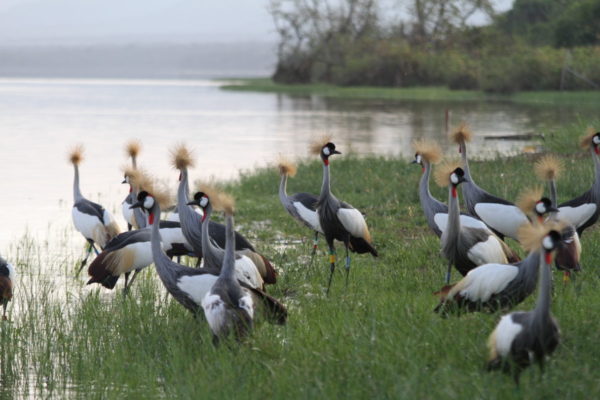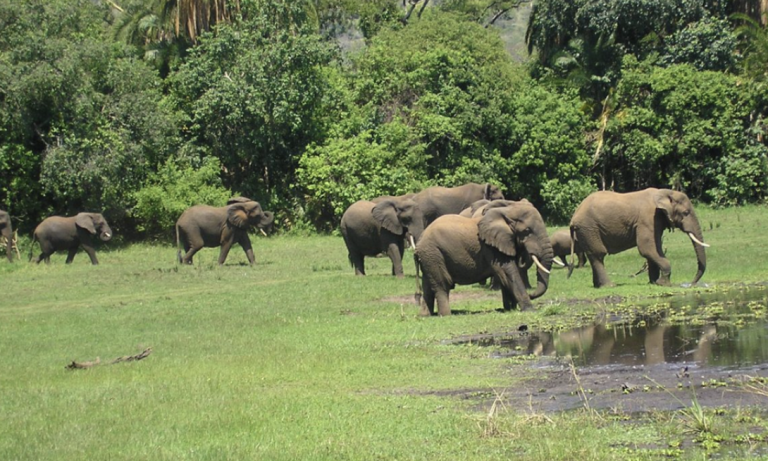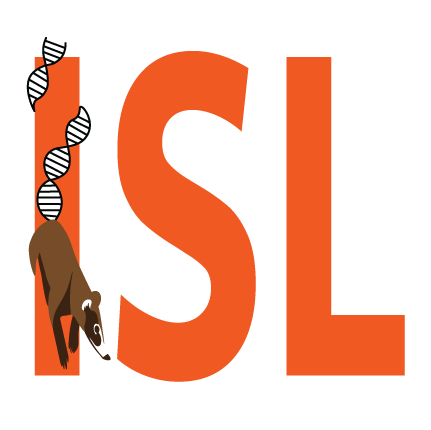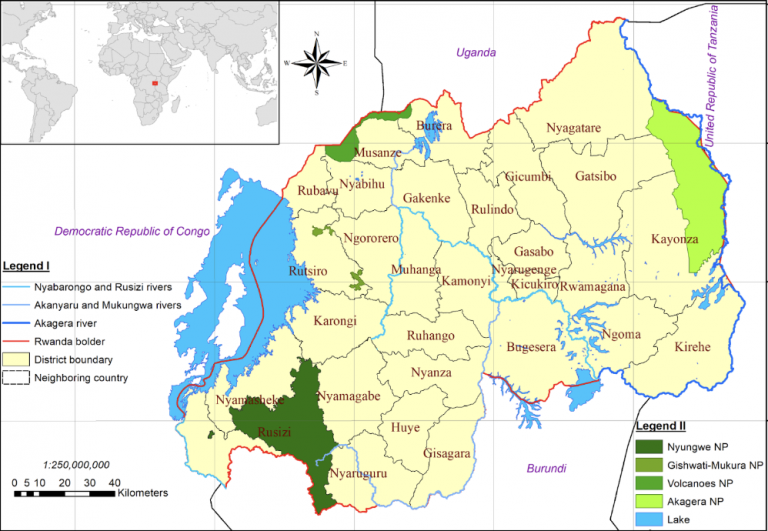ISL Rwanda
Rwanda is a small Central African country, comparable in size to Haiti or the state of Massachusetts, but has the 20th highest population density in the world (525 people/sqkm) with an estimated population of 12 million people in 2021. It’s also part of the Albertine Rift eco-region that is famous for elevated plant and animal diversity, including iconic species such as mountain gorillas, chimpanzees, grey-crowned cranes, African grey parrots and many others. The country has four designated national parks – Akagera, Gishwati-mukura, Nyungwe forest, and Volcanoes National Park – representing just under 10% of the total land area.
The ISL is currently focused on setting-up a dedicated molecular laboratory space for wildlife health research and monitoring at Umusambi Village, near to Kigali. Initial projects will revolve around the Grey Crowned Crane and bat conservation programs of the Rwanda Wildlife Conservation Association (RWCA). Once established and fully operational, we aspire to offer genetics laboratory services to the larger community of wildlife conservation NGOs in the country.

Photo credit: Rwanda Wildlife Conservation Association
Except for the small Gushwati-Mukura reserve, Rwanda’s protected areas are shared with neighboring countries including the Democratic Republic of the Congo to the West, Uganda to the North, Tanzania to the East, and Burundi to the South. The country is divided into four provinces and the city of Kigali, which hosts a disproportionate amount of the population. Among the most densely populated nations in the world with diverse ecological habitats and high species richness, human-wildlife conflict is a challenge. Tourism, agricultural encroachment, subsistence on common natural resources, and proximity to countries elevated wildlife trafficking economies, and climate change contribute to adverse risks and outcomes: 1) zoonotic & anthroponotic disease transmission; 2) tree and animal poaching; 3) wildlife population decline and species extinction; and ultimately, 4) the potential collapse of essential ecological services.
Rwanda is a target country for international conversation and one health advocates (USAID, IUCN, UN, World Bank, WCS, US Forest Service), yet there remains a scarcity of laboratory infrastructure, associated research materials and training opportunities, for many local stakeholders to participate in independent environmental and wildlife disease surveillance projects, which is a One Health goal. Research and tourism surrounding wild primate populations, particularly critically endangered chimpanzees and mountain gorillas, has garnered consistent local and international support, but those efforts too (such as the International Gorilla Conservation Program) have limited access to in-country laboratory resources and still depend on export or foreign collaborations to carry out health or pathogen research. The USAID Predict program established a designated BSL-II molecular laboratory space in collaboration with the Rwanda Development Board (RDB) and Rwanda Agricultural Board (RAB) for the purposes of wildlife disease screening of select viral families. The legacy infrastructure now supports basic viral screening primarily for farm animals, and DNA/RNA classification still requires foreign sequencing services. The Rubirizi National Veterinary Laboratory at the RAB provides basic infrastructure for ELIZA and PCR pathogen testing (though no sequencing) of domestic animals primarily. Another key resource is the National Reference Laboratory (NRL) in Kigali. The NRL is largely dedicated to human health needs, and is responsible for facilitating testing of most standard human diagnostic assays (ELIZA & PCR), has sequencing capacity, and is responsible for genotyping of SARS-COV2, Mycobacterium tuberculosis, HIV, measles and rubella.
The University of Rwanda is a participating member of the African One Health University Network (AFRHUN), which is part of USAID One Health Workforce – Next Generation. In 2017, it helped complete a review of in-country capacity for One Health surveillance work. The report identified a number of critical service and infrastructure gaps:
- Limited capacity to conduct laboratory based surveillance on most zoonotic diseases
- Retention of well trained health professionals is difficult
- Shortage of staff to conduct community level surveillance
- Lack of equipment at the satellite labs
- No general epizootic surveillance system in place
- Standard operating procedure and tools for inter-agency communication and data sharing
These gaps remain equally prevalent today and are actively worked on by AFROHUN members. With ISL Rwanda we also hope to address them but with an alternative decentralized partner network that primarily focuses on surveillance of wildlife communities and human-wildlife conflict mitigation, a well-known (but often neglected) part of One Health frameworks. Our efforts are organized into several phases
This information consists of a subset online resources, links to potential partners and stakeholders, and topics of interest that were incorporated during our planning phase.
- Past & Existing OH Initiatives
– RWANDA MINISTRY OF HEALTH ONE HEALTH STRATEGIC PLAN (2014 – 2018)
– AFROHUN UPDATES CONCERNING RWANDA
– USAID PREDICT PROGRAM REVIEW
- Stakeholders Engaged in Wildlife Monitoring in/around Rwanda
– THE DIAN FOSSEY GORILLA FUND (DFGF)
– WILDLIFE CONSERVATION SOCIETY (WCS)
– VETERINARY INITIATIVES FOR ENDANGERED WILDLIFE (VIEW)
– GORILLA DOCTORS/MOUNTAIN GORILLA VETERINARY PROJECT (MGVP)
– INTERNATIONAL GORILLA CONSERVATION PROGRAM (IGCP)
– AFRICAN WILDLIFE FOUNDATION (AWF)
– INTERNATIONAL UNION FOR CONSERVATION OF NATURE (IUCN)
– FAUNA AND FLORA INTERNATIONAL (FFI)
– WORLD WIDLIFE FUND (WWF)
- In-country Surveillance or Diagnostic Research Infrastructure
– NATIONAL REFERENCE LABORATORY (NRL)
– RWANDA AGRICULTURAL BOARD (RAB) & RUBIRIZI NATIONAL VETERINARY LABORATORY
– UNIVERSITY OF RWANDA
- Predominant Human-Wildlife Interfaces
– Wildlife tourism
– Wildlife trade and poaching
– Local conflict between wildlife and farming (e.g. crop-raiding)
- ISL Rwanda Leadership
– Rwanda Wildlife Conservation Association
– Field Projects International
– US Forest Service
OBJECTIVE 1: Establishment of an insitu (molecular) laboratory space dedicated to wildlife disease surveillance at Umusambi Village in Kigali (RWCA). COMPLETE
Invalid shortcodeOBJECTIVE 2: Procurement of sample-to-sequence laboratory equipment and materials for affordable surveillance research. COMPLETE
Invalid shortcodeOBJECTIVE 3: Carry-out applied molecular laboratory techniques and methodology training course for local leadership. IN PROGRESS
Invalid shortcodeOBJECTIVE 4: Adapt systems and protocols for integrating ongoing wildlife monitoring projects with sample collection and pathogen screening. PENDING
Details surrounding subsequent phases will be provided as they are incorporated into the ISL Rwanda work plan. Tentatively,
- Phase III: Increasing laboratory throughput with automation tools
- Phase IV: Expanding the in-country partner network and communication system
Points of Contact
Dr. Olivier Nsengimana
Executive Director, Rwanda Wildlife Conservation Association
Gideon Erkenswick, Ph.D.
Senior Research Scientist, Field Projects International


